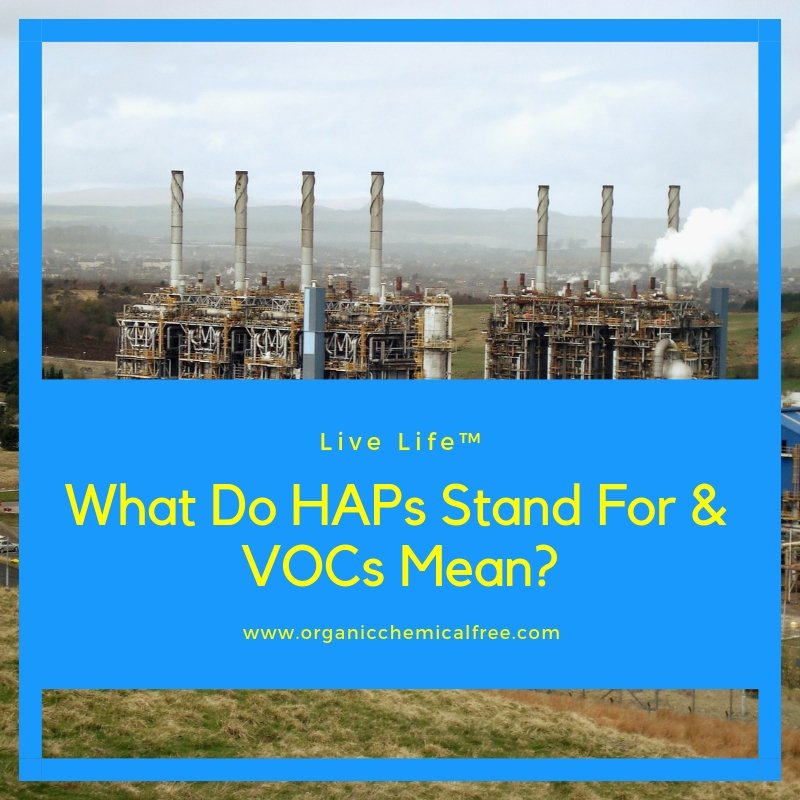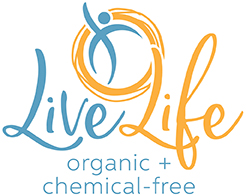Have you heard the acronyms VOC, SVOC, HAP, or CoC tossed around?
Do you know what HAPs stands for?
Maybe the term VOC and off-gassing are more familiar to you. They are used more often.
However, terms like SVOC, HAP and CoC are a bit foreign to most people and not frequently discussed.
Yet.
These chemical families have been around for decades, but are just starting to gain recognition from the public.
So what is this alphabet soup of acronyms and can we use this info when label checking? Keep reading to find out!

VOC: Volatile Organic Compounds.
Beyond knowing what VOC means – volatile organic compounds – it’s important to know what’s happening when we buy products made of VOC ingredients.
This family of chemicals release harmful gasses into the air at room temperature.
Heat and humidity make these chemicals off-gas even more.
Think of the bathroom, kitchen, basement, sauna, and hot sticky days. Each of these spots make the VOCs worse just by their natural and intended use.
Why does this matter?
VOCs are in it for the long haul.
In the beginning, when a product is first made or unwrapped from the packaging it off-gases the most.
As time goes on, the off-gassing of VOCs slows down but never completely ends, even when it’s thrown away or recycled.
Out of sight, out of mind but not out of the environment (still impacting our air quality, soil quality, health).
Plus, that same product with VOCs can show up in our home again!
It sounds like a bad dream or horror movie, doesn’t it?
These bad boys just keep re-appearing. How can that be?
Recycled products, such as plastics or paper that originally were made with VOC chemicals, are still full of those same VOCs – plus the VOCs that were added during re-manufacturing of recycled material.
I’m not suggesting that recycled materials have higher amounts of VOCs, but just making the point that these VOCs never actually go away.
Neither do their related category of chemicals, SVOCs.
SVOC: Semi-Volatile Organic Compounds.
As part of the VOC family, SVOCs are the lesser known and measured group of chemicals releasing harmful gasses into the air.
Like VOCs, SVOCs off-gas at room temperature and even more when heat and/or moisture are present.
There are two key differences between VOCs and SVOCs:
- SVOCs consistently off-gas throughout the entire life of a product (including its post-use life), and
- They are harder for scientists to measure.
This is not to say that they are in-measurable by any means.
The U.S. Population (so, people such as you and I) has more than 100 SVOCs in their body, at measurable levels according to the Lawrence Berkeley National Laboratory.[
When I was first starting to learn about chemicals in our everyday products, I remember coming across these next two categories but didn’t pay much attention.
Not because I dismissed them as unimportant, but because there were too many different chemical lists to digest. At this point in my research, early on, I groaned and closed the screen.
HAPs: Hazardous Air Pollutants.
You might be wondering, are HAPs the same as VOCs?
Sometimes.
The U.S. Environmental Protection Agency (EPA) has a list of over 180 chemicals that they have determined are toxic air pollutants, or Hazardous Air Pollutants.
Each of those chemicals are on the HAP list because, not only are they creating toxic air, but they have a toxic affect on human health and the environment.
Yikes!
Suddenly, this chemical list became more important. Don’t you agree?
Some HAPs are also in the VOC and SVOC chemical families (or fall into other chemical families, too).
In this case, more is not better. :/
Yet, there is more…
CoC: Chemicals of Concern.
The list of Chemicals of Concern existed at one time on the EPA’s website. However, it has been removed as one of the (many) edits the current White House administration has made to government websites (per their message at the top of the website page – this is not a personal political statement).
Places like Environmental Working Group, Safer Cosmetics, and the Healthy Building Network have referenced this chemical list many times, on websites and in articles, over the years.
Thankfully, hopefully, these 3rd part nonprofit organizations saved that info and still use the list of CoCs when determining the healthiness of products.
Can we do the same and use these chemical lists to check labels?
Is Label Checking Effective?
With over 100,000 chemicals listed in the U.S. EPA database, many of which are untested for effects on health and thousands that have been linked to chronic and serious health conditions, it’s impossible for you (or I) to scan every label for each of these chemicals.
Plus, each chemical can have more than one name, making it an even more overwhelming task.
Besides, labeling laws do not require manufacturers to list all ingredients.
In fact, labels don’t have to list any chemicals at all.
Take clothing for example. A clothing tag can say 100% polyester, and not list the ingredients (refined petroleum oil and man-made chemicals) used to make the polyester.
Or the synthetic finishes.
Or the synthetic dyes.
Or the ingredients, such as vinyl, plastic, synthetics, used to create the design or graphics.
… that’s a lot of chemicals not listed on the tag.
And, frankly, I don’t know any one person that has the time or resources to check every single piece of clothing, food, furniture, building materials, picture frame, knickknack, electronic device, appliance, etc. that they buy, anyway.
Final Thoughts
While it’s important for you to be aware of chemical families, looking for chemical names, classifications, and chemical family is not practical.
Instead, get connected to organizations that provide credible information and the simplest, most effective ways to build a chemical-free lifestyle.
Here at Live Life, we do exactly that.
Our educational materials, blog posts, publications are based on credible resources and guide you to create your best organic, chemical-free household – one step at a time.
Want to learn more ways to create the best organic, chemical free household?
